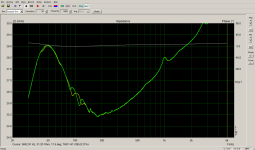I think the Freedom is looking for subjective results that sound satisfactory to him/her, which current drive somehow seems to be able to provide. However, for anyone looking for measurements using the (shunt) technique, here is the paper by the same author cited in the opening post.
Attachments
Last edited:
Re: speaker design, note the VC former design. In the Mills and Hawksford paper above they mention that some of the drivers with non-condictive bobbins achieved 30dB improvements in HD, vs a more typical 10-18 dB for drivers with metal voice coil formers.
So, apparently, even though the conductive bobbins were sliced to reduce eddy currents, the residual currents still had an adverse effect that outweighed any possible benefit from equalising temperatures along the length of the coil. I'd speculate that conductive formers could make a more positive impact at much higher power than what they were testing at. Also, the eddy currents could destabilise the cone by applying forces at various non-right angles.
So, apparently, even though the conductive bobbins were sliced to reduce eddy currents, the residual currents still had an adverse effect that outweighed any possible benefit from equalising temperatures along the length of the coil. I'd speculate that conductive formers could make a more positive impact at much higher power than what they were testing at. Also, the eddy currents could destabilise the cone by applying forces at various non-right angles.
Perfect is a relative term, so just redefine it accordinglyNOTHING IS PERFECT >
Maybe this suggests an explanation? I measured the impedance of the speaker, once in the corner of the room, and then placed it towards the middle of the room.Now why could that be? I've also encountered a phenomenon where, after adding 10 ohm series resistance to an 8 ohm woofer, a 40Hz notch filter for a prominent 'room' (?) mode had to be dialed down to use less attenuation and lower Q. (The exact opposite of what conventional 'wisdom' would suggest ought to happen, especially as it often fails to test to see if reality matches the theory.)
No explanation that I can come up with makes complete sense without considering a possibility the usual T/S based models are borderline broken if the room isn't taken into account.
It seems like the 'overshoot' that (nearly) everyone is always so worried about when Q goes above 0.707 is easily swamped by ringing echoes, but if the speaker Q is raised it could act as an active bass trap. But for that to make sense, there should be some significant loading effects that pressurise the speaker from the outside.
Attachments
- Home
- Loudspeakers
- Multi-Way
- Loudspeaker for current drive
